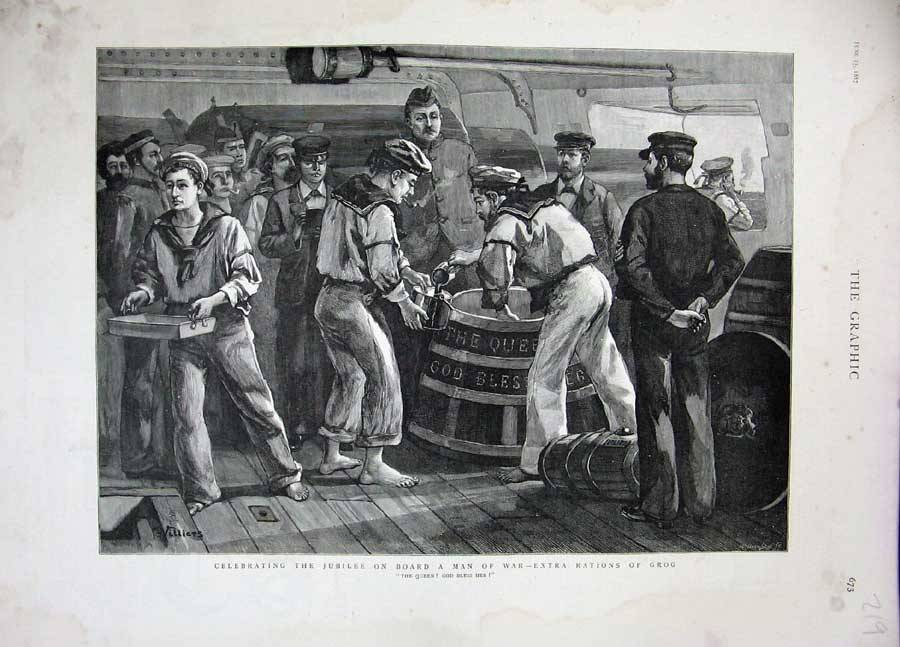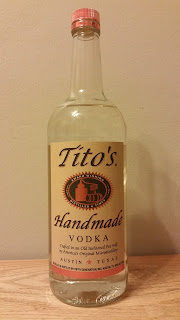This is a post that I've been wanting to do for a while, in part because it celebrates a spirit that I think is under-appreciated by the drinking public at large, and in part as a rehearsal. After a year's hiatus, a good friend (most of those reading this will know exactly who, but this is the internet, so let's keep things comfortably anonymous) has invited me back to run another
holiday party drink extravaganza! I am wildly excited, given what a blast I've had doing these events to date.
One of the
best old-fashioneds I've had in recent memory is a rum variant, and I decided that I'd do my own as part of the lineup for this event. It's a great place to dive in, because it allows for some context around the history and ultimate simplicity of the old-fashioned format. It also provides for a springboard into rum, showing off its historical pedigree, the amazing quality that's available today, and how it can be superbly applied in cocktails. That's what I want to get into with this intro, which will be much longer than what I'd ultimately deliver live (don't worry, Mystery Friend, I'm not planning an extended lecture here) but the written format gives me a chance to structure and lay out my history. Stick with me, we'll get to some tasting soon too.
So:
Rum. The origin of the name is unknown and sports many
colorful theories (as with so many boozy terms) but the term starts appearing in the 1600s, often alongside the even more delightful "kill-devil". This gives a clue for how it was perceived: rough, fiery, potent, and unsavory, a stigma that clings to it even today.
Rum is, by definition, a distillate made from sugarcane, usually from molasses (we'll talk about exceptions later). As it turns out, since yeast eats sugar,
sugarcane will ferment very nicely, and that's been known for thousands of years; a fermented sugarcane drink called
brum has been produced by the Malay people for ages. But more relevant to us, the same fact was re-discovered on early American colonial sugar plantations. Somebody noticed that the
molasses (produced as a byproduct of sugar refining) fermented nicely if allowed to sit in the tropical heat; somebody else then had the genius idea to distill the resulting alcohol, concentrating and preserving it.

What we now call "rum" was born, and it quickly became associated with the sailors who conducted trade in sugar and slaves during the Colonial period. Rum became a hot commodity in the notorious
slave trade that fueled Europe's economic expansion, to the point where the term "rum triangle" became synonymous with the routes. Sugar (along with rum) and other raw materials were shipped to Europe; finished goods like textiles and guns were shipped to Africa; slaves were shipped in horrifying conditions to work the sugar plantations in the Americas, and the whole thing went round again. As the New England colonies grew, a modified route also developed that shipped sugar to New England (to be fermented and distilled), rum and goods to Africa, and slaves back to the West Indies and Caribbean. This isn't exactly the most savory backstory, but it shows you that rum had
heft. It was a major export, which together with cotton and tobacco provided an economic engine driving growth in the early American Colonies. Today's world might look very different without it.
Part of the reason for this popularity is that rum was one of the few distillates available at the time. Whiskey was perhaps being produced in small quantities in the rocky Scottish and Irish islands, but in a rough and barely palatable form. The
column still used to produce clear spirits like vodka and gin hadn't been invented yet. That left brandy, which was expensive, and more importantly for the British, it was
foreign. Rum provided a viable alternative, being made from sugarcane in colonies largely controlled by the British. That in turn provided fuel for a navy full of thirsty sailors.
It seems odd today that a massive military operation could be essentially
powered by booze, but it's true. Consider the conditions. Voyages of any kind across the ocean took weeks or months, and you had to bring all your provisions along with enough space left over for cargo. Crewing a ship took dozens of men, which on the ocean meant not only food but hydration
. Before the days of effective filtration and storage methods, fresh water could become corrupted and spread disease after a few weeks. Instead, ships carried beer (and wine for the officers) which kept longer due to its alcoholic content, and also provided some nutrition - indeed, a significant portion of the average sailor's daily caloric intake came from beer. But beer was no less bulky than water, and would go off if kept for any length of time in the hot and stuffy hold of a ship.
Eventually, British vessels began to carry spirits as well, which took up less cargo space, kept pretty much indefinitely, and which could be used to supplement stocks of fresh water as available.
David Wondrich's Punch! makes a pretty compelling case for punch (the original mixed drink!) being born out of spirits mixed with water to cut down their proof, a concoction known as "grog". Often this was spiked with citrus to combat scurvy, and sweetened for taste. At first grog used a Javanese distillate called
arrack, but rum provided a close substitute that was much easier to find on voyages to and from the Americas. Eventually ships were supplied with even cheaper gin, but not before rum became firmly entrenched as a sailor's drink. In other words, rum was a sort of
military technology, one that kept sailors hydrated, entertained, and scurvy-free when combined with citrus. It helped to power the single greatest navy on the seas, strengthening the British Empire and shaping the history of the Western world. How's
that for heft?
But, back to the modern world. Rum is nowadays produced primarily in the Caribbean islands that hosted the sugar plantations where it was born. Some newer US-based micro-distilleries also make rum, but the producers operating in New England during early colonial days have been supplanted by whiskey distillers. With such extensive history, it's perhaps no big surprise that rum styles have diverged and diffused over the centuries, and just about every island has its own take on the concept. Some use column stills to mass-produce a light, airy product; others stick to older pot stills of unique and arcane design. Some carefully blend different varieties for a smooth, sippable product; others like more spice and bite. Most of what we call "rum" is produced from molasses, but there are variations such as
rhum agricole (produced on former French colonies, such as Haiti and Martinique) and
cachaça (produced in Brazil) are made from fermented whole sugarcane juice instead, which hasn't been processed to refine out the pure sugar. That stuff is a whole different beast in terms of flavor, and less common here in the US anyway.
Just as there's wide variation in style between American, Scottish, Irish (not to mention Canadian and Japanese) whiskeys, there are many different renditions of rum, and it's instructive to taste them next to each other. Or, at least, that's the conceit that I'm operating under. Hence, here are three different rums from three different islands. All three are produced from molasses, moderately aged, and can be found for $25-35 apiece. I consider them all solid, everyday, multi-purpose rums, but they are far from identical, as we'll see.
Plantation Grande Reserve 5 Year Old
About: Let's start with an easy one, made in the tiny island nation of
Barbados. Despite the island's history as a British colony, the rum itself is bottled by
Pierre Ferrand, a French cognac producer who also imports one of my favorite
white rums and one of my highly prized
sipping rums. So I may be biased, but this rum earns points for being a smooth, straightforward product that does very nicely in cocktails while being perfectly enjoyable on its own. It's aged in bourbon barrels in the Caribbean climate, then gets "refined" in French oak casks. The
website suggests that the 5 years on the label is all in the bourbon barrels, so I'm not sure what exactly that last part means, but it has a definite impact on the final flavor.
Tasting Notes: Perhaps predictably, this rum has a lot in common with a relatively-young cognac. It's sweet up front, with a solid apple-pie core, but laced with the ineffable
haut goût (or "hogo" in rum terms) which is
really difficult to define but often sought-after both in older brandies and in rum. There's not a ton here, but it's noticeable, and it opens up the tropical-spicy flavors that begin to dominate the palate. Lots of guava, clove, allspice, vanilla, and a little whiff of coconut too. The finish ends just a little bit spicy, which is enough to draw you in and take another breath of the guava-apple-allspice nose again and start the process all over. This is a bit too smooth for Tiki-style drinks or anything with a lot of citrus, since those are basically designed to compensate for rougher rums, but it's a really good choice for off-beat mixing in stirred drinks (like a rum old-fashioned) and it's a solid sipping rum if you don't want to break the bank.
Pyrat XO Reserve
About: Pyrat is bottled by Patrón (a company you may have heard of) and is sourced from
Guyana. No, not the
French one, the other one; did you know there were two Guyanas in South America? The distillate is undoubtedly a modern product, as seen below; the bottle, as seen to the left, is a squat pirate fantasy not designed with bartenders in mind. Also pay no attention to the "XO" on the bottle; the use of such grading terms is
traditional for brandy, but totally unregulated outside of the French tradition, perhaps doubly so in a former British colony. So there's a lot of questionable branding going on here, but it's not a bad entry-level product inside.
Tasting Notes: This is a less subtle beast than the Plantation, but it has lots of the same sweetness up front. The nose is somewhere between root beer and ginger ale, with a strong whiff of lime peel. It tastes unsurprisingly of molasses, loaded with nutmeg, star anise, allspice, and ginger, which gets sweeter as it sits on the palate. Gradually this develops into a strong sweet orange quality, reminiscent of orange liqueur, with some tropical fruit (papaya?) and funky hogo in the background. Notice a pattern? The sweetness is really overwhelming by the end, but that actually makes it a decent dessert rum, possibly very nice for a rum cake or other confectionery. Pyrat also fits nicely into a Tiki cocktail blend; I'd definitely like this offset with another dry, overproof rum and plenty of citrus.
Matusalem Gran Reserva
About: Although this one says "Cuba" on the bottle, it's actually made in the Dominican Republic, Cuban imports being embargoed until recently. As it turns out, a number of Cuban rum producers left the country after the revolution (you've heard of
Bacardi, right?) and set up shop in neighboring countries to continue their trade. The "15 years" on the bottle isn't the same minimum age that you'll find on whiskey; it's an estimated average, as this is produced using the
solera system. Also used for sherry, madiera, and other dessert wines, this is a method by which the product is fed from barrel to barrel and continuously blended; because the barrels are never fully drained, this means that some fraction of the distillate could be much older than the date on the bottle, though none is exactly as old as stated.
Tasting Notes: My initial impression is that this tastes
older than either of the preceding rums. It's restrained, with a noticeable presence of oak, or cigar box maybe. The nose has little bits of coffee, vanilla, raisin, nutmeg, and orange peel, without any one overwhelming the whole. On the palate, it's the driest rum here, with only a little residual raisin and toffee sweetness not quite balancing things out and leaving the texture little thin. The flavor is as complex as the nose; dried orange, allspice, and vanilla start out, with coffee, tobacco, and oak following but not predominating. The allspice builds toward the finish and the bitter toffee quality returns too, leading things out nicely. The only thing really missing is hogo, which makes this less appropriate as a traditional Tiki rum, but the smoothness is great for mixing in simple cocktails. I particularly like a rum Boulevardier variation* which lets the bitter qualities shine while reinforcing with sweetness.
*
2 oz aged rum, 1 oz Campari (or similar), 1 oz (good) sweet vermouth, 1 dash orange bitters, assembled over a large ice cube. Let's call this one a Privateer, though I'm sure there are plenty other cocktails with that name.
So: rum is pretty variable stuff! Keep in mind that this is just one moderately-aged subset of rums; there's much more variation between categories than displayed here. I'm looking forward to talking about it, among many other things.




































